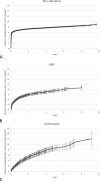Readmissions, revisions, and mortality after treatment for proximal humeral fractures in three large states
- PMID: 31506075
- PMCID: PMC6737688
- DOI: 10.1186/s12891-019-2812-9
Readmissions, revisions, and mortality after treatment for proximal humeral fractures in three large states
Abstract
Background: Proximal humeral fractures can be treated non-operatively or operatively with open reduction and internal fixation (ORIF) and arthroplasty. Our objective was to assess practice patterns for operative and non-operative treatment of proximal humeral fractures. We also report on complications, readmissions, in-hospital mortality, and need for surgery after initial treatment of proximal humeral fractures in California, Florida, and New York.
Methods: The State Inpatient Databases and State Emergency Department Databases from the Healthcare Cost and Utilization Project, sponsored by the Agency for Healthcare Research and Quality, were used for the states of California (2005-2011), Florida (2005-2014), and New York (2008-2014). Data on patients with proximal humeral fractures was extracted. Patients underwent non-operative or operative (ORIF or arthroplasty) treatment at baseline and were followed for at least 4 years from the index presentation. If the patient needed subsequent surgery, time to event was calculated in days, and Kaplan-Meier survival curves were plotted.
Results: At the index visit, 90.3% of patients with proximal humeral fractures had non-operative treatment, 6.7% had ORIF, and 3.0% had arthroplasty. 7.6% of patients initially treated non-operatively, 6.6% initially treated with ORIF, and 7.2% initially treated with arthroplasty needed surgery during follow-up. Device complications were the primary reason for readmission in 5.3% of ORIF patients and 6.7% of arthroplasty patients (p < 0.0001). All-cause in-hospital mortality was 9.8% for patients managed non-operatively, 8.8% for ORIF, and 10.0% for arthroplasty (p = 0.003).
Conclusions: A majority of patients with proximal humeral fractures underwent non-operative treatment. There was a relatively high all-cause in-hospital mortality irrespective of treatment. Given the recent debate on operative versus non-operative treatment for proximal humeral fractures, our study provides valuable information on the need for revision surgery after initial treatment. The differences in rates of revision surgery between patients treated non-operatively, with ORIF, and with arthroplasty were small in magnitude. At nine years of follow-up, ORIF had the lowest probability of needing follow-up surgery, and arthroplasty had the highest.
Keywords: Arthroplasty; Open reduction and internal fixation; Proximal humeral fractures.
Conflict of interest statement
The authors declare that they have no competing interests.
Figures
Similar articles
-
Factors predicting complication and reoperation rates following surgical fixation of proximal humeral fractures.J Bone Joint Surg Am. 2014 Sep 17;96(18):1544-51. doi: 10.2106/JBJS.M.01039. J Bone Joint Surg Am. 2014. PMID: 25232078
-
The incidence of proximal humeral fractures in New York State from 1990 through 2010 with an emphasis on operative management in patients aged 65 years or older.J Shoulder Elbow Surg. 2014 Sep;23(9):1356-62. doi: 10.1016/j.jse.2013.12.034. Epub 2014 Apr 13. J Shoulder Elbow Surg. 2014. PMID: 24725897
-
Hospital readmissions after surgical treatment of proximal humerus fractures: is arthroplasty safer than open reduction internal fixation?Clin Orthop Relat Res. 2014 Aug;472(8):2317-24. doi: 10.1007/s11999-014-3613-y. Epub 2014 Apr 15. Clin Orthop Relat Res. 2014. PMID: 24733446 Free PMC article.
-
Reverse Total Shoulder Arthroplasty Is the Most Cost-effective Treatment Strategy for Proximal Humerus Fractures in Older Adults: A Cost-utility Analysis.Clin Orthop Relat Res. 2022 Oct 1;480(10):2013-2026. doi: 10.1097/CORR.0000000000002219. Epub 2022 May 4. Clin Orthop Relat Res. 2022. PMID: 35507306 Free PMC article.
-
Humeral Shaft Fracture Fixation: Incidence Rates and Complications as Reported by American Board of Orthopaedic Surgery Part II Candidates.J Bone Joint Surg Am. 2016 Sep 7;98(17):e71. doi: 10.2106/JBJS.15.01049. J Bone Joint Surg Am. 2016. PMID: 27605696 Review.
Cited by
-
Readmission, reoperation, and nonhome discharge rates in patients receiving surgical treatment for proximal humerus fractures.JSES Int. 2022 Mar 7;6(4):573-580. doi: 10.1016/j.jseint.2022.02.008. eCollection 2022 Jul. JSES Int. 2022. PMID: 35813141 Free PMC article.
-
Assessing the Risk of Postoperative Complications for Proximal Humeral Fractures Treated by Open Reduction and Internal Fixation in Patients With Diabetes and Chronic Kidney Disease.J Am Acad Orthop Surg Glob Res Rev. 2023 May 10;7(5):e23.00043. doi: 10.5435/JAAOSGlobal-D-23-00043. eCollection 2023 May 1. J Am Acad Orthop Surg Glob Res Rev. 2023. PMID: 37163414 Free PMC article.
-
Analysis of predictors of mortality after surgical and non-surgical management in proximal humerus fractures.J Orthop Traumatol. 2021 Nov 3;22(1):43. doi: 10.1186/s10195-021-00606-7. J Orthop Traumatol. 2021. PMID: 34731349 Free PMC article.
References
-
- Rabi S, Evaniew N, Sprague SA, Bhandari M, Slobogean GP. Operative vs non-operative management of displaced proximal humeral fractures in the elderly: a systematic review and meta-analysis of randomized controlled trials. World J Orthop. 2015;6(10):838–846. doi: 10.5312/wjo.v6.i10.838. - DOI - PMC - PubMed
MeSH terms
Grants and funding
LinkOut - more resources
Full Text Sources
Medical


